Travel in India
The City of joy: Puri

God has created the earth for all of us, but the almighty has kind enough to leave the traces of his benevolence presence on the religious and sanctimonious country, India in the form four dhams for the Hindus across the length and breadth of the nation. The Char Dham is a set of four pilgrimage sites in India. Vaishnavite Hindus believe that visiting these sites helps achieve “Moksha” (salvation). It comprises Badrinath, Dwaraka, Puri and Rameswaram.
The city of joy,Puri has a long and illustrious history to attract the pilgrimages pan across the India as well as the world. According to Cunningham, the ancient name of this town was Charitra, mentioned by the Chinese piligrim Hiuen Tsang as Che-li-ta-lo. But the restoration of the word Che-li-ta-lo as Charitra and its identification with the town of Puri are open to doubt. The importance of the town as a seat of Vaisnavism increased when Chodaganga Deva constructed the temple of Purusottama Jagannath and installed the images of the deities. Thereafter, it became famous as the abode of Purusottama and was popularly called Purusottama Kshetra. The name Purusottama Kshetra was also for sometime known as Purusottama Puri and as the word Purusottama Kshetra was contracted into Kshetra or Chhatra, so also Purusottama Puri was expressed in the contracted form, Puri.
It is one of the most sacred pilgrim centres for the Hindus in the country, and is also referred to as Jagannath (Lord of the Universe) owing to the famous Jagannath temple located here. Situated along the coast of Bay of Bengal in the state of Orissa. Apart from lord Jagannath temple . An ideal weekend getaway for those living in the city of Kolkata and the other neighbouring towns and cities, Puri happens to be one of the most popular beach destinations in the eastern part of the country. Thronged by pilgrims and beach-loving tourists in equal numbers, Puri is a place which has a unique blend of both religious significance and the bucolic beauty of the indented beach. Two of these things together make Puri one of the most popular beach destinations in the eastern part of the country.
The Jagannath Temple
The Shree Jagannath Temple of Puri is an important Hindu temple dedicated to Lord Jagannath, a form of Lord Maha Vishnu, located on the eastern coast of India, at Puri in the state of Odisha. The temple is an important pilgrimage destination. The present temple was rebuilt from the 10th century onwards, on the site of an earlier temple, and begun by King Anantavarman Chodaganga Deva, first of the Eastern Ganga dynasty.
The Puri temple is famous for its annual Ratha Yatra, or chariot festival, in which the three principal deities are pulled on huge and elaborately decorated temple cars. These gave their name to the English term Juggernaut. Unlike the stone and metal icons found in most Hindu temples, the image of Jagannath is made of wood and is ceremoniously replaced every twelve or nineteen years by an exact replica. Jagannath, Balabhadra and Subhadra are a trio of deities worshipped at the temple. The inner sanctum of the temple contains statues of these three Gods carved from sacred neem logs known as Daru sitting on the bejeweled platform or ratnabedi, along with statues of Sudarshana Chakra, Madanmohan, Sridevi and Vishwadhatri. The deities are adorned with different clothing and jewels according to the season. Worship of these deities pre-dates the building of the temple and may have originated in an ancient tribal shrine.
The huge temple complex covers an area of over 400,000 square feet (37,000 m2) and is surrounded by a high fortified wall. This 20 feet (6.1 m) high wall is known as Meghanada Pacheri. Another wall known as kurma bedha surrounds the main temple. It contains at least 120 temples and shrines. With its sculptural richness and fluidity of the Oriya style of temple architecture, it is one of the most magnificent monuments of India. The temple has four distinct sectional structures, namely –
- Deula, Vimana or Garba griha (Sanctum sanctorum) where the triad deities are lodged on the ratnavedi (Throne of Pearls). In Rekha Deula style;
- Mukhashala (Frontal porch);
- Nata mandir/Natamandapa, which is also known as the Jagamohan (Audience Hall/Dancing Hall), and
- Bhoga Mandapa (Offerings Hall).
The main temple is a curvilinear temple and crowning the top is the ‘srichakra’ (an eight-spoked wheel) of Vishnu. Also known as the “Nilachakra”, it is made out of Ashtadhatu and is considered sacrosanct. Among the existing temples in Orissa, the temple of Shri Jagannath is the highest. The temple tower was built on a raised platform of stone and, rising to 214 feet (65 m) above the inner sanctum where the deities reside, dominates the surrounding landscape. The pyramidal roofs of the surrounding temples and adjoining halls, or mandapas, rise in steps toward the tower like a ridge of mountain peaks.
Nila Chakra
The Nila Chakra (Blue Discus) is the discus mounted on the top Shikhar of the Jagannath Temple. As per custom, every day a different flag is waved on the Nila Chakra. The flag hoisted on the Nila Cakra is called the Patita Pavana (Purifier of the Fallen) and is equivalent to the image of the deities placed in the sanctum sanctorum.
The Nila Chakra is a disc with eight Navagunjaras carved on the outer circumference, with all facing towards the flagpost above. It is made of an alloy of eight metals (Asta-dhatu) and is 3.5 Metres (11 feet and 8 inches) high with a circumference of about 11 meters (36 feet). During the year 2010, the Nila Chakra was repaired and restored by the Archaeological Survey of India. The Nila Chakra is distinct from the Sudarshana chakra which has been placed with the deities in the inner Sanctorum.
Nila Chakra is the most revered iconic symbol in the Jagannath cult. The Nila Chakra is the only physical object whose markings are used as a sacrament and considered sacred in Jagannath worship. It symbolizes protection by Shri Jagannath.
The Singhadwara
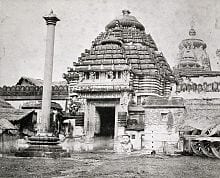
The Singhadwara in 1870 showing the Lion sculptures with the Aruna Stambha Pillar in the foreground. The Singahdwara, which in Sanskrit means The Lion Gate, is one of the four gates to the temple and forms the Main entrance. The Singhadwara is so named because two huge statues of crouching lions exist on either side of the entrance. The gate faces east opening on to the Bada Danda or the Grand Road. The Baisi Pahacha or the flight of twenty-two steps leads into the temple complex. An idol of Jagannath known as Patitapavana, which in Sanskrit, means the “Saviour of the downtrodden and the fallen” is painted on the right side of the entrance. In ancient times when untouchables were not allowed inside the temple, they could pray to Patita Pavana. The statues of the two guards to the temple Jaya and Vijaya stand on either side of the doorway. Just before the commencement of the Rath Yatra the idols of Jagannath, Balabhadra and Subhadra are taken out of the temple through this gate.
Other Entrances
The Ashwadwara Gate
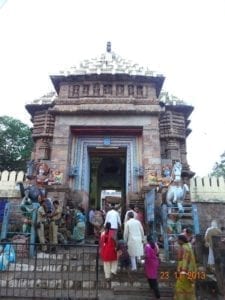
Apart from the Singhadwara, which is the main entrance to the temple, there are three other entrances facing north, south, and west. They are named after the sculptures of animals guarding them. The other entrances are the Hathidwara or the Elephant Gate, the Vyaghradwara or the Tiger Gate and the Ashwadwara or the Horse Gate.
Minor Temples

A cluster of minor temples in the southern part of Jagannath temple complex, including the Vimala Temple.
There are numerous smaller temples and shrines within the Temple complex where active worship is regularly conducted. The Vimala Temple (Bimala Temple) is considered one of the most important of the Shaktipeeths marks the spot where the Goddess Sati’s navel fell. It is located near Rohini Kund in the temple complex. Until food offered to Jagannath is offered to Goddess Vimala it is not considered Mahaprasad.
The temple of Mahalakshmi has an important role in rituals of the main temple. It is said that preparation of naivedya as an offering for Jagannath is supervised by Mahalakshmi. The Kanchi Ganesh Temple is dedicated to Uchchhishta Ganapati. Tradition says the King of Kanchipuram (Kanchi) in ancient times gifted the idol when Gajapati Purushottama Deva married Padmavati, the kanchi princess. There are other shrines namely Muktimandap, Surya, Saraswati, Bhuvaneshwari, Narasimha, Rama, Hanuman, and Eshaneshwara.
The Mandapas

There are many Mandapas or Pillared halls on raised platforms within the temple complex meant for religious congregations. The most prominent is the Mukti Mandapa the congregation hall of the holy seat of selected learned Brahmins. Here important decisions regarding the conduct of daily worship and festivals are taken. The Dola Mandapa is noteworthy for a beautifully carved stone Torana or arch which is used for constructing a swing for the annual Dol Yatra festival. During the festival, the idol of Dologobinda is placed on the swing. The Snana Bedi is a rectangular stone platform where idols of Jagannath, Balabhadra, and Subhadra are placed for ceremonial bathing during the annual Snana Yatra.
Astonishing facts about Jagannath Temple in Puri
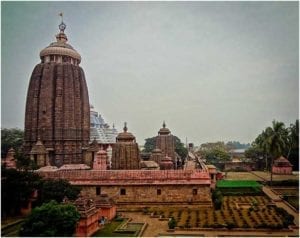
Jagannath, Balabhadra and Subhadra are a trio of deities worshipped at the temple. The inner sanctum of the temple contains statues of these three Gods carved from sacred neem logs known as Daru sitting on the bejeweled platform or ratnabedi, along with statues of Sudarshana Chakra, Madanmohan, Sridevi and Vishwadhatri. The deities are adorned with different clothing and jewels according to the season. Worship of these deities pre-dates the building of the temple and may have originated in an ancient tribal shrine.
It took three generations worth of time and effort to brick up the humongous walls of the famous Puri’s Jagannath Temple located in Odisha. The temple is of utmost importance to the Hindu devotees as it is one of the Char-Dham Pilgrimages. It also serves as a mighty historical structure built about millennia ago, in the year 1078. Millions of people visit Odisha to gain Lord Jagannath blessings.
The temple is famous for its annual Rath Yatra which is witnessed by millions as the three colossal chariots carry the deities. The English word Juggernaut shares its origin from this annual parade. But that’s not the sole specialty of the place! Some enigmatic activities without any scientific explanations have caught the travelers eye worldwide. Here are some of these mind-boggling facts –
1. Defying Nature’s Code of Conduct
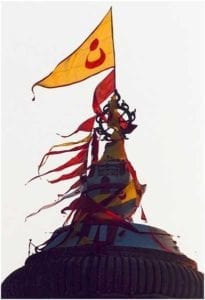
Even a child knows any piece of cloth is dominated by the wind to fly according to its course. The same principle has numerous applications; from the giant sails on your ship to a small flag in your hand all follow the same code. But it looks like the flag mounted on the top of the Jagannath Temple is a unique exception to the principle. This particular flag flows in the opposite direction to the wind’s course without any scientific background to back it up.
2. The Climb
Every day a priest scrambles the walls of the temple with a height equivalent to that of a 45 storey building, to change the flag atop the temple dome. This ritual dates far back to the day the temple was built. The practice is done with bare hands without any protective gear. It’s believed if the ritual is skipped one day from the calendar, the temple will be shut down for a long 18 years. This might make the professional climbers jealous.
3. Light with no darkness
A necessary detail while sketching anything is shading. Shading happens when sunlight glows one part of the subject leaving a shadow on the other, which ultimately triggers shade. But, what if something has no shadow?
The temple is reported to have no shadow at all, at any time of the day from any directions possible. Could it be an architectural marvel or the Lord Jagannath’s message to humanity?

- The Riddle of the Sudarshan Chakra
There are two mysteries present at the pinnacle of the temple in the form of the Sudarshan Chakra. The first oddity revolves around the theory of how the hard metal weighing about a tonne, just got up there without any machinery just with a human force of that century.
The second is one deal with the architectural technique related to the Chakra. From every direction you look, the Chakra looks back with the same appearance. It’s like it was designed to look just the same from every direction.
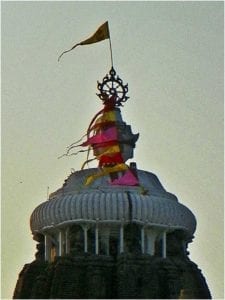
5. Nothing’s above God, so nothing flies above it either
The sky is the bird domain. We see birds sitting, resting and flying above our heads and rooftops all the time. But, this particular area is restricted, not even a single bird is encountered above the temple dome, even an airplane could not be seen hovering above the temple. Might be because Lord Jagannath doesn’t want the view of his holy mansion to be disturbed!

- The Food is never futile here
In Hindu mythology, wasting food is considered a bad sign; the Temple crew follows the same. A total number of people visiting the temple varies between 2,000 to 2, 00,000 people every day. Miraculously, the Parsadam prepared every day is never wasted, not even a bite. Could this be effective management or the Lord’s will?
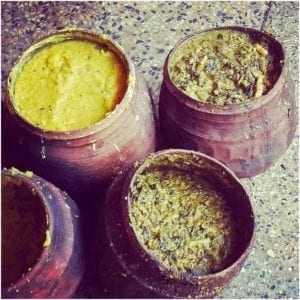
7. Mute water
Seconds, after you put the first step inside the temple from Singha Dwara entrance, the audibility to the ocean waves is entirely lost. This phenomenon is more prominent in the evening time. Again, no scientific explanation adds up to this fact. The sound returns when you leave the temple.
According to the local lore, it was the will of the Subhadra Mayi, the sister of the two lords who wished for serenity within the temple gates. Hence her will was duly fulfilled.

8. Reverse gear of the breeze
Take any place on Earth, on daytime the breeze from the sea comes to land and the opposite happens in the evening. But, in Puri, the breeze has a tendency to contradict and opt for the exact opposite direction. In the daytime, the breeze blows from land to sea and the opposite in the evening happens.
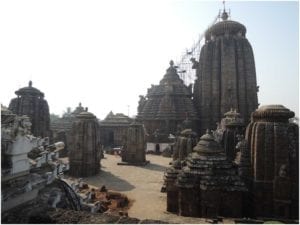
9. Magical methods to cook
The traditional way to cook the Parsadam is preserved by the priests here. Exactly seven pots are used as vessels mounted over one another and are cooked using firewood. Enchantingly, the top most pot is cooked first, and the rest follows the same order!

- Deities Disintegration
The deities are buried from every 14 to 18 years, one above another, replaced by new ones. These deities are made up of neem wood and are believe to be disintegrated on their own.

- The Rath Yatra
The Rath Yatra is an annual parade in which the deities are carried outside the temple on 2 set of chariots (3 each). The first chariot carries the deities till the river which separates the Jagannath Temple and the Mausi Maa temple. After that, the idols are boarded in 3 boats to cross the river. Now the second chariot comes in play. It carries the deities from the river to the Mausi Maa Temple where the ritual takes place.

The beautiful beach
The bucolic beautiful beach has lots to offer visitors to attract them. The fun and frolic and excitement and enthusiasm among the sightseers about the protracted and salubrious beach definitely going to leave an indelible scar on the memory down the line. It is said that by taking the bath at Mahodadhi literally means great ocean or sea to purge all the papas or sins and help in rejuvenating the pilgrims.
Other attractions of Puri
Apart from the Lord Jagannath temple and beach, other prominent places which create attractions are Gundicha temple, Loknath temple, Narendra Sarovar, Markendsavara temple, Shree Gaur Vihar Ashram and many others.
The city is well connected by rail and bus transportation and besides that, it is only 60 km away from the capital of Odisha, Bhubaneswar. The boarders can easily fetch luxurious and sophisticated hotels to spend their time and for relaxations.
To conclude and to be candid the splendor and grandeur of the Puri temple accompanied by the gigantic almighty Lord Jagannath give immense personal gratification for the present and rest of the life for the pilgrims. The pilgrim must visit once in the life to get the chance glimpse of all-mighty to find the route to satisfaction and salvation.






























Ajay Kumar Pradhan
August 1, 2019 at 4:20 AM
Fantastic description on Lord of Lords of the Earth….It’s a rare blending of reason with spiritual vision
Bishnu pada Choudhury
August 1, 2019 at 10:34 AM
The Author gives good information about Jagannath temple of puri which is easily perceptible by common reader.
Sarada
August 1, 2019 at 10:47 AM
Thanks for valuable suggestion. Looking forward to future for ure comments and support.